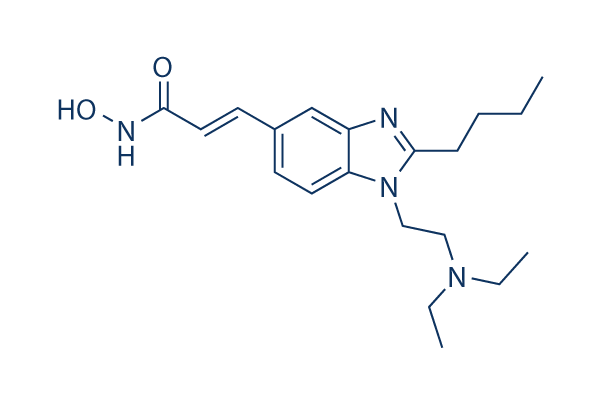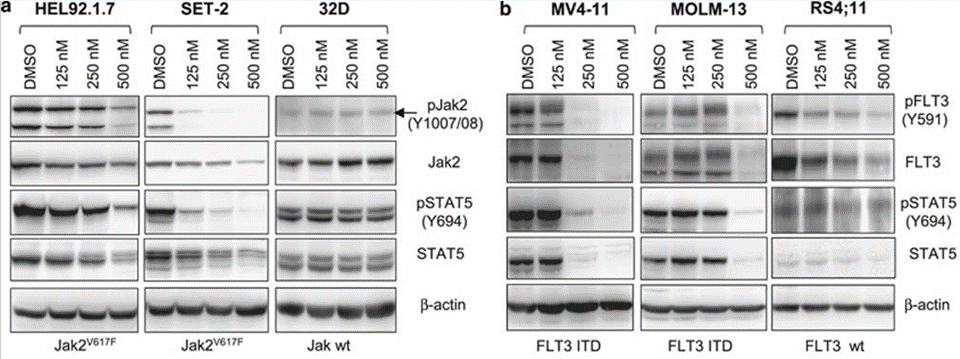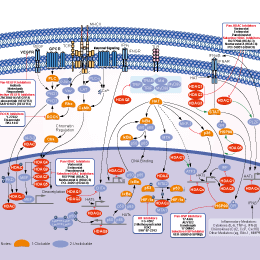
- Bioactive Compounds
- By Signaling Pathways
- PI3K/Akt/mTOR
- Epigenetics
- Methylation
- Immunology & Inflammation
- Protein Tyrosine Kinase
- Angiogenesis
- Apoptosis
- Autophagy
- ER stress & UPR
- JAK/STAT
- MAPK
- Cytoskeletal Signaling
- Cell Cycle
- TGF-beta/Smad
- DNA Damage/DNA Repair
- Compound Libraries
- Popular Compound Libraries
- Customize Library
- Clinical and FDA-approved Related
- Bioactive Compound Libraries
- Inhibitor Related
- Natural Product Related
- Metabolism Related
- Cell Death Related
- By Signaling Pathway
- By Disease
- Anti-infection and Antiviral Related
- Neuronal and Immunology Related
- Fragment and Covalent Related
- FDA-approved Drug Library
- FDA-approved & Passed Phase I Drug Library
- Preclinical/Clinical Compound Library
- Bioactive Compound Library-I
- Bioactive Compound Library-Ⅱ
- Kinase Inhibitor Library
- Express-Pick Library
- Natural Product Library
- Human Endogenous Metabolite Compound Library
- Alkaloid Compound LibraryNew
- Angiogenesis Related compound Library
- Anti-Aging Compound Library
- Anti-alzheimer Disease Compound Library
- Antibiotics compound Library
- Anti-cancer Compound Library
- Anti-cancer Compound Library-Ⅱ
- Anti-cancer Metabolism Compound Library
- Anti-Cardiovascular Disease Compound Library
- Anti-diabetic Compound Library
- Anti-infection Compound Library
- Antioxidant Compound Library
- Anti-parasitic Compound Library
- Antiviral Compound Library
- Apoptosis Compound Library
- Autophagy Compound Library
- Calcium Channel Blocker LibraryNew
- Cambridge Cancer Compound Library
- Carbohydrate Metabolism Compound LibraryNew
- Cell Cycle compound library
- CNS-Penetrant Compound Library
- Covalent Inhibitor Library
- Cytokine Inhibitor LibraryNew
- Cytoskeletal Signaling Pathway Compound Library
- DNA Damage/DNA Repair compound Library
- Drug-like Compound Library
- Endoplasmic Reticulum Stress Compound Library
- Epigenetics Compound Library
- Exosome Secretion Related Compound LibraryNew
- FDA-approved Anticancer Drug LibraryNew
- Ferroptosis Compound Library
- Flavonoid Compound Library
- Fragment Library
- Glutamine Metabolism Compound Library
- Glycolysis Compound Library
- GPCR Compound Library
- Gut Microbial Metabolite Library
- HIF-1 Signaling Pathway Compound Library
- Highly Selective Inhibitor Library
- Histone modification compound library
- HTS Library for Drug Discovery
- Human Hormone Related Compound LibraryNew
- Human Transcription Factor Compound LibraryNew
- Immunology/Inflammation Compound Library
- Inhibitor Library
- Ion Channel Ligand Library
- JAK/STAT compound library
- Lipid Metabolism Compound LibraryNew
- Macrocyclic Compound Library
- MAPK Inhibitor Library
- Medicine Food Homology Compound Library
- Metabolism Compound Library
- Methylation Compound Library
- Mouse Metabolite Compound LibraryNew
- Natural Organic Compound Library
- Neuronal Signaling Compound Library
- NF-κB Signaling Compound Library
- Nucleoside Analogue Library
- Obesity Compound Library
- Oxidative Stress Compound LibraryNew
- Plant Extract Library
- Phenotypic Screening Library
- PI3K/Akt Inhibitor Library
- Protease Inhibitor Library
- Protein-protein Interaction Inhibitor Library
- Pyroptosis Compound Library
- Small Molecule Immuno-Oncology Compound Library
- Mitochondria-Targeted Compound LibraryNew
- Stem Cell Differentiation Compound LibraryNew
- Stem Cell Signaling Compound Library
- Natural Phenol Compound LibraryNew
- Natural Terpenoid Compound LibraryNew
- TGF-beta/Smad compound library
- Traditional Chinese Medicine Library
- Tyrosine Kinase Inhibitor Library
- Ubiquitination Compound Library
-
Cherry Picking
You can personalize your library with chemicals from within Selleck's inventory. Build the right library for your research endeavors by choosing from compounds in all of our available libraries.
Please contact us at [email protected] to customize your library.
You could select:
- Antibodies
- Bioreagents
- qPCR
- 2x SYBR Green qPCR Master Mix
- 2x SYBR Green qPCR Master Mix(Low ROX)
- 2x SYBR Green qPCR Master Mix(High ROX)
- Protein Assay
- Protein A/G Magnetic Beads for IP
- Anti-Flag magnetic beads
- Anti-Flag Affinity Gel
- Anti-Myc magnetic beads
- Anti-HA magnetic beads
- Magnetic Separator
- Poly DYKDDDDK Tag Peptide lyophilized powder
- Protease Inhibitor Cocktail
- Protease Inhibitor Cocktail (EDTA-Free, 100X in DMSO)
- Phosphatase Inhibitor Cocktail (2 Tubes, 100X)
- Cell Biology
- Cell Counting Kit-8 (CCK-8)
- Animal Experiment
- Mouse Direct PCR Kit (For Genotyping)
- New Products
- Contact Us
Pracinostat (SB939)
Pracinostat (SB939) is a potent pan-HDAC inhibitor with IC50 of 40-140 nM with exception for HDAC6. It has no activity against the class III isoenzyme SIRT I. Pracinostat (SB939) induces apoptosis in tumor cells. Phase 2.

Pracinostat (SB939) Chemical Structure
CAS No. 929016-96-6
Purity & Quality Control
Batch:
Purity:
99.99%
99.99
Pracinostat (SB939) Related Products
Signaling Pathway
Cell Data
| Cell Lines | Assay Type | Concentration | Incubation Time | Formulation | Activity Description | PMID |
|---|---|---|---|---|---|---|
| MCF7 cells | Proliferation assay | 48 h | Antiproliferative activity against human MCF7 cells after 48 hrs by sulforhodamine B assay, GI50=0.17 μM | 24119555 | ||
| NCI-H460 cells | Proliferation assay | 48 h | Antiproliferative activity against human NCI-H460 cells after 48 hrs by sulforhodamine B assay, GI50=0.22 μM | 24119555 | ||
| HCT116 cells | Proliferation assay | 48 h | Antiproliferative activity against human HCT116 cells after 48 hrs by sulforhodamine B assay, GI50=0.24 μM | 24119555 | ||
| MDA-MB-435 cells | Proliferation assay | 48 h | Antiproliferative activity against human MDA-MB-435 cells after 48 hrs by sulforhodamine B assay, GI50=0.48 μM | 24119555 | ||
| OVCAR5 cells | Proliferation assay | 48 h | Antiproliferative activity against human OVCAR5 cells after 48 hrs by sulforhodamine B assay, GI50=0.61 μM | 24119555 | ||
| HepG2 | Antimalarial assay | Antimalarial activity against exo-erythrocytic form of Plasmodium berghei infected in human HepG2 cells, IC50 = 0.15 μM. | 24904967 | |||
| HepG2 | Antiplasmodial assay | 53 hrs | Antiplasmodial activity against exoerythrocytic-stage of Plasmodium berghei ANKA infected in human HepG2 cells after 53 hrs by DAPI staining-based method, IC50 = 0.15 μM. | 28241112 | ||
| Sf9 | Function assay | 2 hrs | Inhibition of recombinant human HDAC-2 expressed in baculovirus infected insect Sf9 cells using Fluor de Lys as substrate preincubated for 2 hrs followed by substrate addition measured after 10 mins by fluorescence assay, Ki = 0.016 μM. | ChEMBL | ||
| HEK293-F | Function assay | 2 hrs | Inhibition of recombinant human HDAC-8 expressed in HEK293-F cells using Fluor de Lys as substrate preincubated for 2 hrs followed by substrate addition measured after 10 mins by fluorescence assay, Ki = 0.016 μM. | ChEMBL | ||
| Sf9 | Function assay | 2 hrs | Inhibition of recombinant human HDAC-1 expressed in baculovirus infected insect Sf9 cells using Fluor de Lys as substrate preincubated for 2 hrs followed by substrate addition measured after 10 mins by fluorescence assay, Ki = 0.016 μM. | ChEMBL | ||
| Click to View More Cell Line Experimental Data | ||||||
Biological Activity
| Description | Pracinostat (SB939) is a potent pan-HDAC inhibitor with IC50 of 40-140 nM with exception for HDAC6. It has no activity against the class III isoenzyme SIRT I. Pracinostat (SB939) induces apoptosis in tumor cells. Phase 2. | |||||||||||
|---|---|---|---|---|---|---|---|---|---|---|---|---|
| Features | A new histone deacetylase inhibitor based on hydroxamic acid, with improved physicochemical, pharmaceutical, and pharmacokinetic properties. | |||||||||||
| Targets |
|
| In vitro | ||||
| In vitro | SB939 has a 100-fold greater selectivity for HDACs than for Zn-binding non-HDAC enzymes, receptors, and ion channels. SB939 is a potent inhibitor of HDAC class I isoenzymes, HDAC1, HDAC2, HDAC3 and HDAC8 with the IC50 values ranging from 43 nM to 140 nM. SB939 inhibits HDAC class II isoenzymes , HDAC4, HDAC5, HDAC7, HDAC9 and HDAC10 significantly with the IC50 values ranging from 40 nM to 137 nM, with the exception of HDAC6 which shows IC50 of 1008 nM. It markedly inhibits HDAC11 of the HDAC class IV enzymes with IC50 of 93 nM, but shows no inhibitory activity against SIRT 1 of the class III HDACs. SB939 shows significant antiproliferative activity against a wide variety of tumor cell lines, especially Leukemia cells and cutaneous T-cell Lymphoma cells with IC50 values ranging from 50 nM (H9 cells) to 170 nM (HEL92.1.7 cells). [1] |
|||
|---|---|---|---|---|
| Kinase Assay | HDAC enzyme assay | |||
| All recombinant HDAC enzymes, with the exception of SIRT1, are cloned and expressed in S*BIO. The reaction mix containing 2.5 or 5 μL of the HDAC isoenzyme, assay buffer (25 mM Tris-HCl, pH 7.5; 137 mM NaCl; 2.7 mM KCl, 1 mM MgCl2 and 1 mg/mL BSA), different concentrations of SB939, and the fluorogenic deacetylase substrate Flour de LysTM in a total reaction volume of 33 μL is incubated at room temperature for 2 hours. 16 μL of Flour de LysTM developer is added and incubated for an additional 10 minutes. The emitted light is measured at 460 nm in a microplate reader. IC50 values are generated using the XLfit software. | ||||
| Cell Research | Cell lines | HCT116, A2780, ACHN, MCF7, HL-60, et al. | ||
| Concentrations | Dissolved in DMSO (stock concentration, 10 mM), final concentrations 1.5 nM to 100 μM | |||
| Incubation Time | 96 hours | |||
| Method | Cells are seeded in 96-well plates in the log growth phase at a predetermined optimal density, and rested for 24 hours (adherent cells) or 2 hours (suspension cells), respectively. They are exposed to different concentrations of SB939 for 96 hours. Cell proliferation assays are done using either the CyQUANT cell proliferation assay kit for adherent cells or the CellTiter96 Aqueous One solution cell proliferation kit for suspension cells. |
|||
| Experimental Result Images | Methods | Biomarkers | Images | PMID |
| Western blot | p-JAK2 / JAK2 / p-STAT5 / STAT5 / p-FLT3 / FLT3 |

|
22829971 | |
| In Vivo | ||
| In vivo | Administration of SB939 (25 mg/kg to 100 mg/kg) displays a dose-dependent antitumor efficacy in a xenograft mice model of human colorectal cancer (HCT-116). This is approximately twice as efficacious as SAHA: SB939 causing a tumor growth inhibition of 94% versus 48% by SAHA with both at the maximum tolerated dose. Oral administration of SB939 at a dose of 50 mg/kg or 75 mg/kg in the APCmin genetic mice model of early-stage colon cancer markedly reduces the number of tumors , decreases cumulative hemocult scores and increases hematocrit values more effectively. [1] |
|
|---|---|---|
| Animal Research | Animal Models | BALB/c nude mice bearing HCT-116 human colon cancer xenografts, Male and APCmin mice |
| Dosages | 25, 50, 75, or 100 mg/kg | |
| Administration | Oral gavage once daily | |
| NCT Number | Recruitment | Conditions | Sponsor/Collaborators | Start Date | Phases |
|---|---|---|---|---|---|
| NCT02118909 | Completed | Healthy Volunteers|Non-smokers |
Helsinn Healthcare SA |
May 2014 | Phase 1 |
| NCT02058784 | Completed | Healthy Volunteers|Moderate to Heavy Smokers|Non-smokers |
Helsinn Healthcare SA|Celerion |
February 2014 | Early Phase 1 |
| NCT01112384 | Completed | Metastatic Sarcoma |
NCIC Clinical Trials Group|S*BIO|Canadian Cancer Trials Group |
October 21 2010 | Phase 2 |
| NCT00741234 | Completed | Solid Tumors|Hematologic Malignancies|Myelodysplastic Syndrome |
S*BIO |
April 2007 | Phase 1 |
Chemical Information & Solubility
| Molecular Weight | 358.48 | Formula | C20H30N4O2 |
| CAS No. | 929016-96-6 | SDF | Download Pracinostat (SB939) SDF |
| Smiles | CCCCC1=NC2=C(N1CCN(CC)CC)C=CC(=C2)C=CC(=O)NO | ||
| Storage (From the date of receipt) | |||
|
In vitro |
DMSO : 72 mg/mL ( (200.84 mM) Moisture-absorbing DMSO reduces solubility. Please use fresh DMSO.) Ethanol : 27 mg/mL Water : Insoluble |
Molecular Weight Calculator |
|
In vivo Add solvents to the product individually and in order. |
In vivo Formulation Calculator |
||||
Preparing Stock Solutions
Molarity Calculator
In vivo Formulation Calculator (Clear solution)
Step 1: Enter information below (Recommended: An additional animal making an allowance for loss during the experiment)
mg/kg
g
μL
Step 2: Enter the in vivo formulation (This is only the calculator, not formulation. Please contact us first if there is no in vivo formulation at the solubility Section.)
% DMSO
%
% Tween 80
% ddH2O
%DMSO
%
Calculation results:
Working concentration: mg/ml;
Method for preparing DMSO master liquid: mg drug pre-dissolved in μL DMSO ( Master liquid concentration mg/mL, Please contact us first if the concentration exceeds the DMSO solubility of the batch of drug. )
Method for preparing in vivo formulation: Take μL DMSO master liquid, next addμL PEG300, mix and clarify, next addμL Tween 80, mix and clarify, next add μL ddH2O, mix and clarify.
Method for preparing in vivo formulation: Take μL DMSO master liquid, next add μL Corn oil, mix and clarify.
Note: 1. Please make sure the liquid is clear before adding the next solvent.
2. Be sure to add the solvent(s) in order. You must ensure that the solution obtained, in the previous addition, is a clear solution before proceeding to add the next solvent. Physical methods such
as vortex, ultrasound or hot water bath can be used to aid dissolving.
Tech Support
Answers to questions you may have can be found in the inhibitor handling instructions. Topics include how to prepare stock solutions, how to store inhibitors, and issues that need special attention for cell-based assays and animal experiments.
Tel: +1-832-582-8158 Ext:3
If you have any other enquiries, please leave a message.
* Indicates a Required Field
Tags: buy Pracinostat (SB939) | Pracinostat (SB939) supplier | purchase Pracinostat (SB939) | Pracinostat (SB939) cost | Pracinostat (SB939) manufacturer | order Pracinostat (SB939) | Pracinostat (SB939) distributor







































